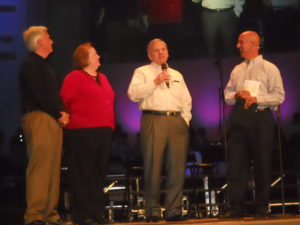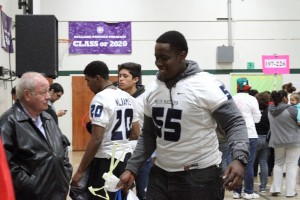6 Stones: An Oral History
PART I – A Community In Transition
JOHN MEADOR, Pastor, Cross City Church (2006-Present):
“I really love talking about 6 Stones Mission Network, and part of that is because I see it as being a very God-sized kind of work that took place during a time when our community had a vacuum or a void. That’s really how it started. We saw a vacuum and a void, and we weren’t able to meet the need.”
GENE BUINGER, Superintendent, Hurst-Euless-Bedford ISD (1999-2013):
“What I see in 6 Stones is the fulfillment of that recognition that there’s a mission, and the mission doesn’t have to be separated by an ocean. The mission can be right down the road.”
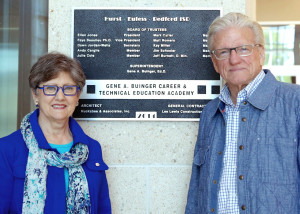
Gene and Mary Kay Buinger pose with the dedication plaque at the Buinger Tech Center in Bedford. Photo by Steven A Jones, 6 Stones
“The Hurst-Euless-Bedford Independent School District is a school district of over 20,000 students and 30 different campuses. It’s quite a large school district. We have a gamut of — like most public schools — different ethnicities, different languages spoken at home, and certainly different family incomes. As the school district has evolved, like many public school districts located in urban areas, the majority of the students’ families in HEB today are from families that live below the Federal Poverty Level. Thus, each rental payment, each last week of the pay period, becomes a mini-crisis for these families. That makes it very difficult to learn.”
“We can have the very best teachers, we can have all of the assets that you need to have — technology, extracurricular activities, all of those things that are important to make a school district successful — but the big problem was going to be the families. So many of them were living at the poverty level or below… There were so many needs for families, but the School District’s ability to provide was very limited.”
MEADOR: “I came here in 2006. I moved from Chattanooga, TN, where I’d been for seven years. But prior to that, I’d been in Irving, TX, for seven years pastoring… Irving was going through its own transition during those years I was pastoring, so I had some background in what a city looks like when it goes through major demographic transition. How does the church respond? How does the city respond?”
“I knew what was going to happen in the city, to a degree. And I knew what could happen in the city, to a degree. That kind of flavored my thinking about this city.”
BUINGER: “The schools can be excellent, but the child still suffers by not having that stability that many of us look back to our own childhood and see where we were very fortunate to have a stable family situation, a situation in which one working parent could provide adequate support for the family. That was the situation in HEB, and it’s really a credit to John Meador that he saw this experience out in the community and recognized that the church had a responsibility to the neighborhoods.”
JEFF BURNETT, Pastor, First Baptist Church – Hurst (1991-Present):
“You talk about the changes that have occurred in HEB ISD — of course I grew up here — and… my fifteen years on the school board was one of the greatest joys of my life. Probably in the second or third year, we had a demographer come in and share with us the changing demographics and what we needed to anticipate and prepare for.”
GARY MCKAMIE, City Manager, City of Euless (2007 – 2015):
“The period of time that birthed 6 Stones was a downturn in the economy, locally. So we had lots of properties that were depressed. Lots of foreclosures. There was lots of need, and the city cannot meet everyone’s needs all the time. There are certain needs that people have that the city should not even try to meet. But in that particular time frame, there were just many, many needs.”
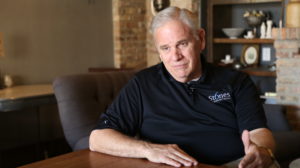
Retired Euless City Manager sits for an interview with 6 Stones Mission Network. Photo by Cody Bettis, 6 Stones.
“Thirty years ago — or longer — this church was very instrumental in giving help. There was less need then, but we always knew that if you could get someone through the doors of this church to the church offices, that they would get some help. Be it a meal or a motel room or whatever, there was always help available. And there was a period of time that, in the years prior to 6 Stones, that help wasn’t necessarily here. The local benevolence was not what it should be, probably. As a church member, I had a certain degree of frustration because I would see and hear about foreign mission trips — people would go to Israel, they’d go to Africa, they would go all over the world — but we had needs locally, and really those same people from some of these countries actually had immigrated and lived here. They were starving or they had no place to live, no good roof over their heads. And there wasn’t a lot of help… from any of the churches.”
“We just needed someone who cared about people locally. That was probably one of the greatest things that came out of the earliest conversations: we found people who actually knew each other already and were friends. We found this willingness to cooperate and to act on that care. Not just from this church; from many other churches and government organizations. From business groups. They cared; they really didn’t know how to act on that care. And that was the greatest thing about what happened in the years to come.”
MEADOR: “We had a staff member in our church who actually lived in the Manchester Apartments; just blocks from our church, and from 6 Stones. One of the buildings burned down. Three of the resident families in those buildings had someone they could go to for help with a new home, a new place to live, new furnishings, et cetera. But one particular woman — all alone, didn’t have anyone to help her — approached our church through one of these staff members who was working in the complex in order to reach people. He came to me and said ‘can we help this woman?’ At the time, our church had just gotten through a huge time of debt and debt retirement. We had just retired the debt. We had placed six large stones out in our garden, representing the $6 million+ that were paid off over 28 months. Which is a miracle in itself!”
“So the church was coming back from a debt financially, but it had circled the wagons when it came to helping the community. We just needed to get our debt taken care of, that’s how our policy read. We could not help this woman. I stood at the doorway of my office on that day and was broken. I have compassion — everybody does that has Christ, we have compassion — but I happened to lead a very large organization called First Euless. A church that, now, is debt-free. But the policies prevented us from helping this woman at this time in this way. I couldn’t sleep. And because I couldn’t sleep, I began to pray and just ask God ‘what is next? How can we live in a community like this, that has needs, and be aware of those needs and not meet those needs?’”
“We discovered that there was no one in the HEB area that actually had a ministry that could help people like this. We had the New Hope Center, but that wasn’t what this woman needed. She needed more than food. More than clothing. She needed a rebuild of some sort. That turned into a time of prayer and fasting with our staff. After 21 Days of that, I believed that God was leading us to start something. And I asked Scott Sheppard to do it: pull together a network of churches; pull together a network of organizations. Let’s have a ministry that meets the needs in our community, in the name of Christ, for the purpose of the Gospel, showing the compassion of Christ.”
JIM PACK, Missions Pastor, Restoration Church (1998-2012) / 6 Stones Board (2009-2013):
“Scott was an unusual guy… a guy that can make things happen. So I think we started with full belief that it could happen. We just used the Braille Method: we just felt our way around in those early days. We were working on things like coming up with a name, coming up with people we could meet with. We would hear about little programs here and there and we’d go be a part of them; we’d visit to see what they were doing. We looked at homeless housing, English-as-a-Second-Language programs. We didn’t give ourselves any parameters, other than trying to stay in our area at that time, HEB. We were hoping it might expand out of that at some time. But we were just getting involved and finding very receptive people everywhere we went.”
“It was just a concept. An idea of churches and ministries, businessmen and businesses, and organizations joining together to make a difference in our community… when they announced it, I thought ‘I want to do that.’ I’ve always loved being involved. I’ve always had a dream for what’s happened with this, to see the city and the church, corporations, businesses, and people find common ground. And then to have somebody actualize it so that it has wheels to run on.”
MEADOR: “I knew it had to be a coalition. I knew it had to be a nonprofit organization from my past experiences. People are just not as free to partner with churches as they are with a nonprofit, even a faith-based nonprofit. We knew our church was not big enough to meet all the needs in the area. If we had started an arm of ministry in our church alone, we knew that wouldn’t be enough. But we also knew this was going to be about the Kingdom. It wasn’t a denomination or a church. It was about the Kingdom. It was about what God is doing. And we knew there was a great number of people of faith in this community. We wanted to include them. We didn’t know if they would show up, but we knew that the opportunity was important.”
MCKAMIE: “There’s different motivations that people have in trying to achieve the same thing. But if you can find a means by which everyone can play a part, everyone can fulfill their own needs for a common goal; everyone gets a little credit. Everyone gets some satisfaction. It allows everyone to pull in the same direction.”
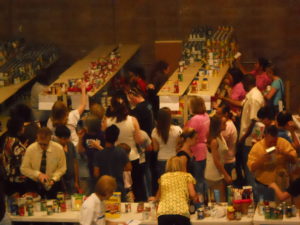
Volunteers sort food donations in the 6 Stones warehouse during the early days of the New Hope Center.
MEADOR: “It all began with points of need. People would come alongside us to help us with that need. And as 6 Stones Mission Network began as a nonprofit, for Scott, the name 6 Stones was a natural fit. The name, of course, harkened back to a time of financial brokenness in our church, that God provided for — and provided above and beyond that — so that we could start a Mission Network like 6 Stones. Our church voted one Sunday morning, with me as a new pastor proposing something very unusual: ‘Let’s take a quarter of a million dollars and let’s just start something that would help meet the need.’ Our church rose unanimously, and I was scared to death. I thought: ‘These people don’t even know who I am. I haven’t been here but a year and a half. And we’re asking them to approve a large expenditure about a mission I can’t really identify fully. I can describe it, but we don’t know what this thing is going to look like.’ So I look at our people in our church and say these were people of faith.”
BURNETT: “Scott Sheppard and I sat down in the restaurant over by the church, and he started laying out [his ideas], and I’m going ‘ok, there’s a difference between being a visionary and being absolutely out of your mind.’ And I’m not sure which one I thought he was at that point. But he would go to the school district — he would go to Dr. Buinger, the Superintendent at that point — and he would say ‘what does the District need?’ And once he heard and was able to identify the need, he just went to work trying to bring the resources to meet what that particular need was. I’ve seen it occur time and time and time and time again. You have a hard time not getting excited because his enthusiasm is absolutely contagious. And that’s been one of the things that have coalesced this District together with all of those resources. He believed so strongly — being a product of this district and giving his life for this District — you kind of have a hard time saying ‘no' when you see someone that passionate about investing in kids.”
MEADOR: “ I think Scott’s question, frequently, was ‘how can we help you?’ Dr. Buinger had this amazing background, coming out of West Texas where demographic change had already taken place, and he already knew something about how to do that and navigate that. He was doing that here very successfully. He’s a problem-solver, a great mind, and passionate about people. Those guys were asking the right questions and getting some great answers. As money materialized, as people gave or volunteers with 6 Stones would just dive in and say ‘let’s see what God will do with this,’ it grew rapidly.”
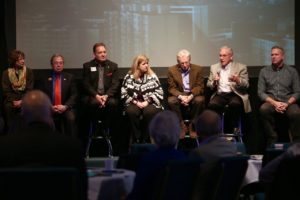
From the left: Faye Beaulieu, United Way; Tarrant CountyJudge Glen Whitley; Dan Alderson, Atmos Energy; Kim Campbell, TXU Energy; Gene Buinger, Former Superintendent of HEB ISD; Gary McKamie, Former City Manager of Euless; and John Meador, First Baptist Church of Euless.
BUINGER: “I certainly knew that this church had the ability to be a ground-breaker in this initiative. Just receiving the call, I knew this was really important. But I certainly had no way of knowing what John’s real vision was: the creation of what became 6 Stones. The level of resources that he saw that was necessary to get it off the ground was exceptional. That was a big surprise.”
PACK: “We loved the early days. Everybody was so excited. I can remember spontaneous Board meetings. There were five of us on the Board then, and we’d just go meet in a restaurant. We’d do business for half the time and the other half, we’d just laugh and talk about what was going on in our lives. But as we grew, we brought in reputable people from reputable organizations that had skill sets that they brought to the table which were critical. So it became much more business-like, but it allowed us to function much more economically by doing it that way. If we’d have operated the way we started, five years later we would have been in a mess!”
BUINGER: “I have collaborated with lots of churches, both here in HEB and in other communities. And some of them are really some of the greatest examples of what can be done, as I think back over the years. But not any of those prior collaborations were to the size and scale of 6 Stones. Certainly, the number of families that were impacted, and have been positively impacted, is due to the fact that John committed a level of resources to this task, and I think without a doubt saw its success as something that would be critical for the overall success of the church.”
BURNETT: “Because of our confidence in Scott and John and everybody over here in Euless, it was a natural fit for us. Just knowing their hearts and how it paralleled with what some of our folks were already doing, it just was a natural progression and partnership… we can just become much more effective and get much more done for the sake of the community and the sake of the Gospel under an umbrella. And that umbrella has been 6 Stones. I tell the HEB ISD story and the 6 Stones story everywhere I go and people are just amazed that a community can come together — with all different factions — and do things for and in a school district that 6 Stones is doing. I just point them here. You want an example of it really working? This is where it does.”
PACK: “I think we hoped, from the beginning — I’m not sure if we had faith to believe for this much — but [the growth of 6 Stones] was our hope. We could see it and taste it. But it’s hard. Any time that you’re doing something like this, one of the things that ultimately is required is time and money. Those are hard commodities to get out of people. But once you’ve set up something like a CPR weekend — and it’s well-organized, and people feel like they’ve been treated well; that their time has been valued and they’ve had viable work — you’ve got something that will sustain itself. I think that’s a foundational piece of 6 Stones. Everything we did, we set it up so that there’s not a chance to fail. But we need the people to make it happen. They’ve gladly come, gladly been a part of it. They take pride in it. Because ultimately, they know that they’re changing the lives of people that can’t otherwise have much of a chance to have a good shot at life.”
MEADOR: “The first ten years was really characterized by just those four or five initiatives that really began to grow and expand and touch lives. But another piece is that our community embraced this so enthusiastically. It wasn’t a difficult thing to find people to stand up and say ‘I want to be a part of that.’ It wasn’t hard for businesses to make themselves available, it seems. It wasn’t hard for schools at all. Schools were so cooperative and so eager.”
PACK: “One of the things we learned was that people want to help other people. They just don’t have the mechanism to make it happen. Once we started this, even the neighbors of these people would come by while we were working on a house and say ‘how do you get involved in this? How can we be involved?’”
MEADOR: “I do believe that people want to help others. It’s there in every life. It can be calloused, it can be repressed, it can be preoccupied. But when you give someone an opportunity, they tend to want to take it. They tend to get a taste of that, and they want to help people. 6 Stones has given an avenue. It’s a pipeline that people can get into that really has a product of love and compassion and really helping the betterment of other people. It’s a conduit you get in, and once you get in, it’s a ride. It’s a great ride and it affects a lot of people.
“Ten years later, it still is magnetic to people who hear about it.”
NEXT: An Oral History of Community Powered Revitalization (CPR)

